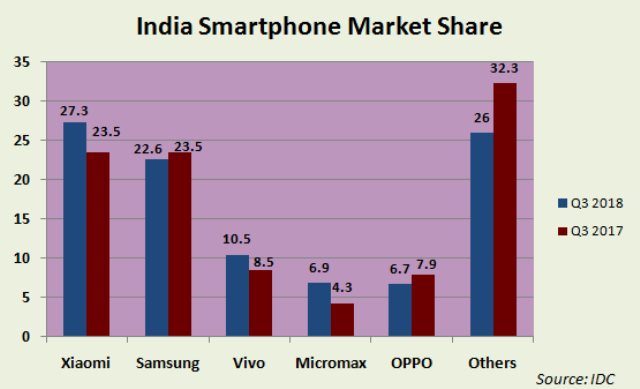Smartphone makers in India are demanding export credits on devices and tariff cuts on machinery imports as part of the Budget 2019 recommendations, Reuters reported.
 Though India has more than 1 billion phone connections, the country is yet to become the global smartphone manufacturing hub. Major smartphone brands such as Samsung, Xiaomi, Oppo, Vivo, Huawei, among others, have started their smartphone assembly facilities as part of Made in India initiatives started in 2014.
Though India has more than 1 billion phone connections, the country is yet to become the global smartphone manufacturing hub. Major smartphone brands such as Samsung, Xiaomi, Oppo, Vivo, Huawei, among others, have started their smartphone assembly facilities as part of Made in India initiatives started in 2014.
“As India is nearing to achieve saturation point… without an export take off smartphone manufacturing growth cannot be sustained and accelerated,” said the India Cellular and Electronics Association (ICEA) in its budget recommendations to the India Government.
The government’s Make in India campaign and gradual tax increases on imports of mobile phone components have boosted the creation of more than 260 manufacturing units in the country and over 600,000 jobs, ICEA said.
That has helped India become the second-biggest producer of mobile phones after China, and prompted foreign smartphone makers such as Oppo and Samsung Electronics as well as contract manufacturers like Wistron and Hon Hai Precision Industry (Foxconn) to ramp up production for phones primarily sold domestically.
The mobile phone industry is now set for a further boost under a broader National Policy on Electronics currently in the works.
Next month, India will begin taxing imports of touch panels two months earlier than initially planned, sending mixed messages to handset manufacturers as setting up the means to assemble panels locally is a significant expense.
“Consistency in policy is important for any industry to mature,” said Navkendar Singh, associate research director at IDC. “Back-and-forth in policy hurts investor sentiment and the country’s positioning as a destination to manufacture.”
ICEA proposed the government raise the export credit received on the value of mobile phone shipments to 8 percent from 4 percent. It also called for the introduction of a 5 percent export credit on services such as mobile apps.
Other proposals from ICEA include lower import taxes on capital goods such as machinery and ensuring manufacturers have access to low-cost capital.
“The next phase of manufacturing can probably be driven by export incentives,” said Vikas Agarwal, India head of Chinese smartphone maker OnePlus, which is not an ICEA member.
“The eventual goal is to establish India as the preferred destination – and not just driven by duties, but by the opportunities in the Indian market.”
The ICEA, formerly the Indian Cellular Association, also called on the government to re-consider levying duties on new components, and allow for the local manufacture of parts already under the import tax regime to develop in a timely manner.
The import tariff on touch panels has been of particular concern to manufacturers including Samsung.
The South Korean firm has written to India government saying it cannot make two of its high-end models in India because of the tariff, the Economic Times reported.
Samsung is investing in a touch panel assembly plant in India which would ready by the end of March 2020.
The government aims to export $9 billion worth of mobile phones in the year ending March 2020 from just $100 million in 2017, the ICEA said in a previous report.





